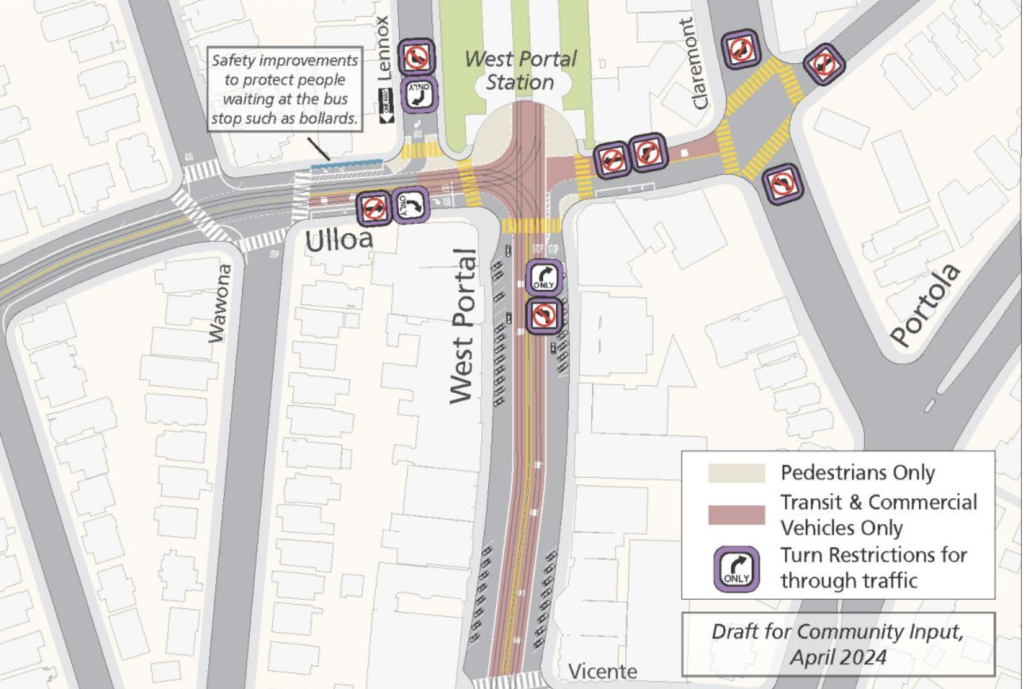Supervisor Myrna Melgar, Mayor London Breed, and SFMTA Director Jeffrey Tumlin have attempted to redirect traffic on the first block of the West Portal Avenue. The proposed changes would hurt West Portal Avenue businesses, cause traffic congestion, and destroy the character of surrounding neighborhoods.
From the San Francisco Standard, April 18:
“If it were up to me, I would take all of the cars off West Portal,” Melgar said. “I think that this plan takes most of the cars off the intersection, and that is my goal.”
The Melgar and Tumlin plan was so hated by Westside residents and businesses that the SFMTA was forced to allow residents and business leaders three additional months to form a committee to evaluate impacts to parking and traffic congestion, and “come to a consensus that works for all parties,” according to a statement from Melgar’s office. Prior to the committee formation, the SFMTA had done none of these evaluations.

Originally, Melgar had proposed only a 10-day community outreach period to accept the SFMTA’s proposed slow streets plan. The West Portal plan was not well. The plan looked as if it was drawn-up on a Peet’s coffee napkin in five minutes.
Melgar, who represents District 7, is the vice-chair of the Transportation Authority Board. Tumlin was appointed by the mayor. The SFMTA is governed by a seven-member Board of Directors who are also appointed by the mayor and confirmed by the supes. The SFMTA’s Citizen Action Committees are appointed either by the Mayor or the board.
The SFMTA’s Slow Streets road experiments are causing more accidents and business failures than they are stopping.
The transportation experiment on Valencia Street has failed by any transportation metric. SF Chronicle, April 12, 2024: “According to the SFMTA’s three-month evaluation of the new Valencia Street bikeway, 12 crashes between cyclists and cars occurred between August and October—a higher accident rate than before the bike lane opened. It didn’t help that new traffic rules on the eight-block corridor, including the elimination of left turns, created confusion. In September, a left-turning driver killed an 80-year-old pedestrian at Valencia and 18th streets.
More from the Chron:
“In the past six months, at least ten businesses have closed on Valencia Street. Reports suggest that many more business are on the verge of shuttering. Another rough couple of months, and “FOR SALE” signs might cover much of the eight-block corridor.”
The SFMTA’s experiment has caused one Valencia merchant to go on a thirty day hunger strike. The SFMTA does not care about traffic congestion in surrounding neighborhoods, parking, nor the health of small businesses and/or the local residents.
The Slow Street on Lake Street—against the public’s will—is another looming traffic fiasco.
The SFMTA listened to neighborhood complaints and then altered Lake Street the way they wanted too. The SFMTA is claiming that they have reduced traffic to 1,000 vehicles a day. This is a false traffic count. Lake Street residents have installed pneumatic traffic counters that are counting almost 2,000 vehicles per day.
The SFMTA is no stranger to hyperbole about plans and exaggerating results.
San Francisco Examiner, January 8, 2024:
“I feel like it’s (Lake Street) in this terrible middle place where it’s not great for drivers and it’s not great for people using the slow street as a slow street,” said Natalie Kleefeld, who lives in the neighborhood and regularly walks Lake Street with her five-year-old daughter. “It’s kind of in this in-between.” “Someone’s gonna get hit,” Kleefeld said. “It’s just a matter of time.”
The SFMTA’s safe streets “Vision Zero” program is a failure.
In 2014, after suffering 30 traffic fatalities, the city created the Vision Zero program, which “represents the City’s commitment to eliminating traffic deaths on our streets by 2024. Through building better and safer streets, educating the public on traffic safety, enforcing traffic laws and adopting policy changes, we can save the lives of all road users — people who walk, bike, drive, or ride public transit. Achieving Vision Zero requires leadership and commitment from City agencies, elected officials, community stakeholders, the public and the private sector to find the right solutions for San Francisco.”
Apparently, Tumlin does not have the necessary leadership or commitment skills to make Vision Zero work.
In December 2022, the SFMTA Board of Directors approved a permanent Slow Streets Program.
In 2023, the SFMTA issued a report called the “2023 slow streets Evaluation report.” The report stated that 18 percent of slow street traffic was reduced. A median speed of 15 miles per hour or slower was achieved.
The median fifteen MPH is an average between zero and 30. Thus, many cars are going 30 MPH or faster.
The SFMTA is also claiming that slow streets reduce collisions by 48 percent. This is a total fabrication as they have made the surrounding streets much more dangerous. Accidents are bound to happen, but they will not be included in the SFMTA’s slow streets analysis if a collision occurs on a side street.
The SFMTA cannot demonstrate one example of having ever saved a life through quick-builds, road diets and/or slow streets. Over the last ten years, there have been 253 traffic fatalities. Most likely, the changes the SFMTA are experimenting with will cause a false sense of security and cause more traffic and business problems.
“Street design did not factor into a fatal crash that killed a family of four in West Portal earlier this month,” according to an initial report from the San Francisco Municipal Transportation Agency.
SFMTA officials’ provided collision details of the March 16 crash in an update to The City’s traffic-death tracking dashboard, noting that the site of the crash that ultimately killed a family of four had highly visible yellow crosswalk markings, solid double-yellow lines constituting a barrier and signs warning drivers not to pass.
“In recent years, pedestrian safety zones with delineators were added,” the report said. It also found that the intersection had no reported injury collisions in the last five years. Staff recommendations included repairing signs that were damaged in the accident.”
The SFMTA cannot claim to be blameless regarding the West Portal Avenue accident and then hide behind the shield of “safety” by remodeling West Portal. It is obvious that the SFMTA changes will begin the destruction of West Portal Avenue
Why did the SFMTA—with an estimated $12.7 million 2024 budget deficit—try to change what is not broken within a ten-day public summary period?
Public comments against the West Portal redesign will be heard, then ignored. Unfavorable summaries and letters will disappear. The SFMTA never met with the Midtown Terrace Homeowners Association and then claimed how the homeowners were for the redesign of Twin Peaks Boulevard—absolutely not true.
Project mitigation will amount to larger signs, wider walkways and/or pedestrian walkways that are white, green, and violet and then changed to violet, green, and white. This is how the SFMTA mitigation process operates.
The West Portal Committee negotiating with the SFMTA should develop a strong Memorandum of Understanding and then vigorously verify what the SFMTA does. Verify, verify, verify… but please do not trust.
George Wooding has served as president of the Coalition of San Francisco Neighborhoods.






